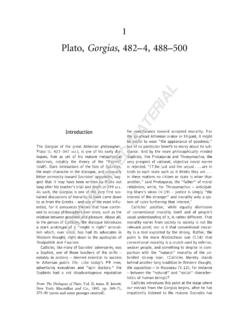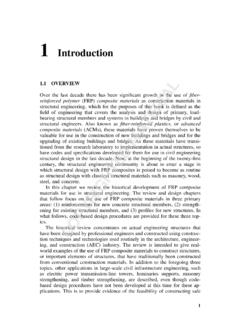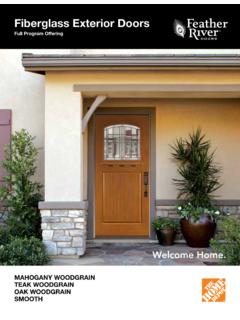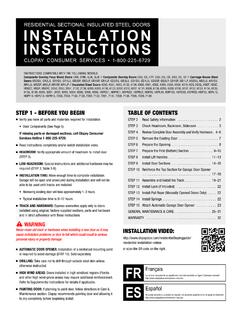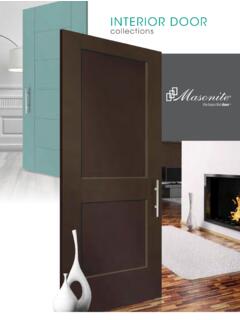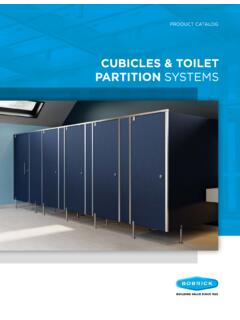Transcription of An Introduction to the Interior Design Profession - Wiley
1 ChapterOneAn Introduction tothe Interior DesignProfessionWe spend over 90 percent of our day in Interior this, most of us take interiors for granted,barely noticing the furniture, colors, textures, andother elements let alone the form of the space ofwhich they are made. Sometimes, of course, the designof the Interior does catch our attention. Maybe it s thepulsing excitement of a casino, the rich paneling of anexpensive restaurant, or the soothing background of areligious Introduction TO THE Interior Design PROFESSION1As you are reading this book, you obviously have an interest in interiors andinterior Design .
2 It might be because you have always enjoyed rearranging thefurniture in your home. Maybe you like to draw imaginative floor plans forhouses. It could be that a relative or friend is a contractor and you have beeninvolved in the actual construction of a building in some Design professionals provide the owners of homes and many kindsof businesses with functionally successful and aesthetically attractive interiorspaces. An Interior designer might specialize in working with private residencesor with commercial interiors such as hotels, hospitals, retail stores, offices, anddozens of other private and public facilities.
3 In many ways, the Interior designprofession benefits society by focusing on how space and Interior environ-ment should look and function. By planning the arrangement of partitionwalls, considering how the Design affects the health, safety, and welfare of occu-pants,selectingfurnitureandothergoo ds,andspecifyingaestheticembellish-ments for the space, the designer brings the Interior to life. A set of functionaland aesthetic requirements expressed by the client becomes Interior Design Profession is much more than selecting colors and fabricsand rearranging furniture. The professional Interior designer must considerbuilding and life safety codes, address environmental issues, and understandthe basic construction and mechanical systems of buildings.
4 He or she must ef-fectively communicate Design concepts through precisely scaled drawings andother documents used in the industry. The professional Interior designer space-plans the rooms and the furniture that goes into them, determining location ofpartition walls, selecting colors, materials, and products so that what is sup-posed to occur in the spaces actually can. Another critical responsibility con-cerns how to manage all the tasks that must be accomplished to complete a2 BECOMING AN Interior DESIGNER project as large as a 1,000-room casino hotel or as small as someone s Interior designer must also have thebusiness skills to complete National Council for Interior Design Qualification (NCIDQ)
5 An inde-pendent agency whose purpose is to administer an examination testing thecompetency of Interior designers for professional licensing and associationmembership offers the following definition of the Interior Design profes-sional. It was developed with the cooperation of practicing Interior designersand educators:The professional Interior designer is qualified by education, experienceand examination to enhance the function and quality of Interior the purpose of improving the quality of life, increasing produc-tivity and protecting the health, safety and welfare of the public, theprofessional Interior designer: analyzes the client s needs, goals and life safety requirements; integrates findings with knowledge of Interior Design .
6 Develops and presents final Design recommendations throughappropriate presentation media; prepares working drawings and specifications for non-loadbearing Interior construction, materials, finishes, space plan-ning, furnishings, fixtures and equipment; collaborates with licensed practitioners who offer professionalservices in the technical areas of mechanical, electrical and load-bearing Design as required for regulatory approval; prepares and administers bids and contract documents as theclient s agent; reviews and evaluates Design solutions during implementationand upon Introduction TO THE Interior Design PROFESSION3 Professional Interior designers are not Interior decorators and Interior dec-orators are not professional Interior designers, although the public generallydoes not see any difference.
7 Interior Design isnotthe same as is the furnishing or adorning a space with fashionable or beautifulthings. Decoration, although a valuable and important element of an Interior ,is not solely concerned with human interaction or human behavior. Interiordesign isallabout human behavior and human interaction. 2 Although a professional Interior designer might provide Interior decorationservices, an Interior decorator does not have the education and experience toperform the many other services of a professional Interior designer. A decora-tor is primarily concerned with the aesthetic embellishment of the interiorand rarely has the expertise, for example, to produce the necessary drawingsfor the construction of non load-bearing walls and certain mechanical sys-tems that are routinely produced by a professional Interior AN Interior DESIGNERH istoryC O M P A R E D T O M A N Y other profes-sions, the Interior Design Profession has arelatively short history.
8 Architects, arti-sans, and craftspeople completed interi-ors before Interior decorators beganoffering their services. Architects createdthe Design of a building s structure andoften the interiors. They would engagecraftspeople to create and produce thefurnishings needed to complete the inte-rior. Other artisans lent their expertisewith decorative embellishments and theproduction of handmade pieces for theinterior. Of course, all this was accom-plished for the world of the wealthy andthe mighty not the average historians have credited Elsie deWolfe (1865 1950) as the first person tosuccessfully engage in Interior decora-tion as a career separate from architec-ture.
9 At about the turn of the twentiethcentury, de Wolfe established a career byoffering Interior decoration services toher society friends in New York City. She was an actress and a society figurebefore she began to remodel her ownhome, transforming typically Victorianrooms with stylish simplicity by usingwhite paint, cheerful colors, and floweryprinted chintzes. 3 Her friends recog-nized her alternative decor, which was agreat contrast to the dark, deep colorsand woods of Victorian interiors. She isalso believed to be among the first deco-rators to charge for her services ratherthan be paid only a commission on thegoods she sold to door opened for this Profession atthe turn of the twentieth century for sev-eral reasons.
10 One was the developmentof new technologies during the nine-teenth-century Industrial Revolution thathelped make possible machine-made fur-nishings and other mass-produced items werecheaper and more available to the aver-age consumer. As demand for thesegoods grew, department stores a newconcept in the nineteenth century began displaying the new products inAN Introduction TO THE Interior Design PROFESSION5 Ethical StandardsThe consequencesof unethicalbehavior by politicians, business lead-ers, sports figures, and many othersare widely discussed in the behavior by all members of oursociety is expected, though not standards help thoseengaged in a specific Profession under-stand what is considered right andwrong in the performance of the workof the Profession .
